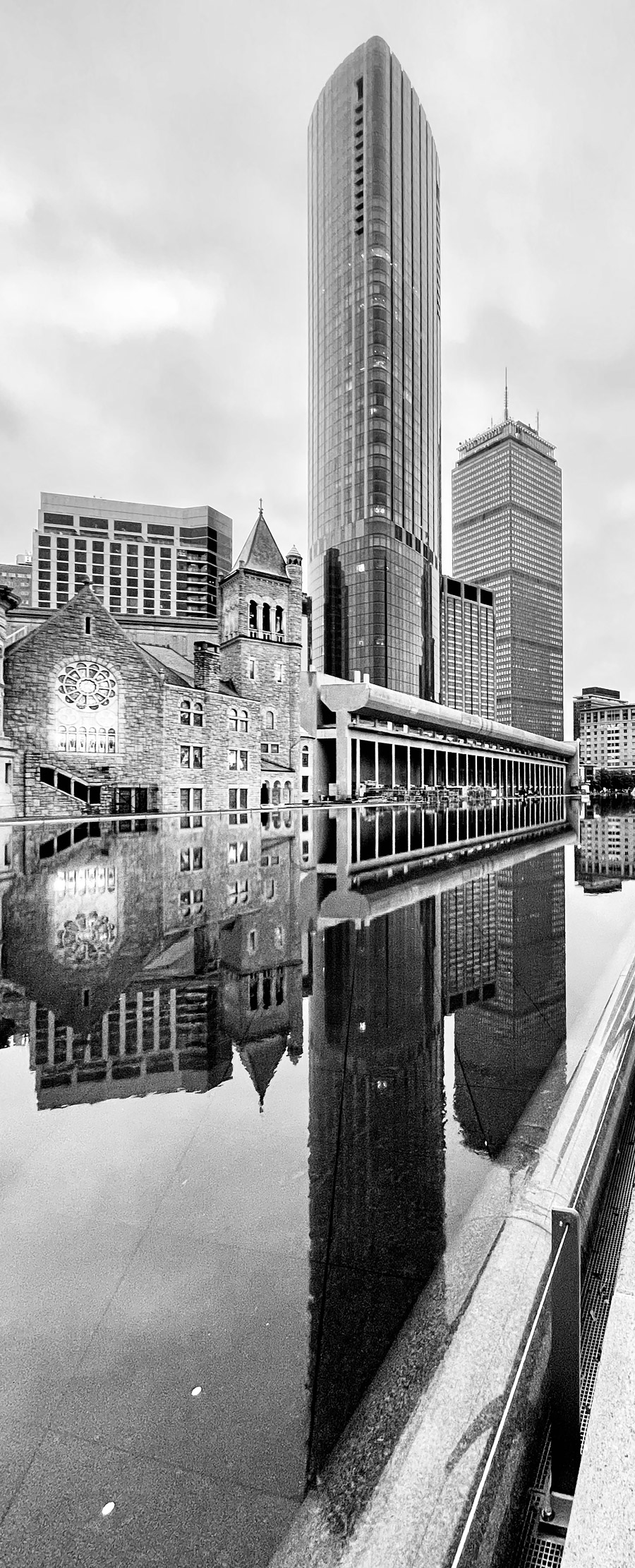The 61-story hotel and condominium tower known as One Dalton is done. Rising 742 feet, it is the tallest residential building in Boston, just 48 feet shy of the city’s tallest structure, 200 Clarendon (originally known as the John Hancock Tower). Both were designed by the late Henry Cobb, of Pei Cobb Freed & Partners, and, in a way, they bookend Cobb’s long career.
Built in 1976, the Hancock Tower provoked a fierce public backlash due to its height and proximity to Copley Square, where it looms over H.H. Richardson’s Trinity Church and McKim, Mead & White’s Boston Public Library. “The building’s restraint to the point of muteness, its refusal to reveal anything other than its obsession with its urban context, is surely its greatest strength but also its ultimate limitation as a work of architecture,” Cobb wrote in his memoir, Words & Works, 1948–2018: Scenes From a Life in Architecture. “Despite the forcefulness of its gesture, the tower remains virtually speechless, and this resolute self-denial is, in the end, both its triumph and its tragedy.”
The most distinguishing feature of the Hancock Tower is its abstraction: singular, minimal, and monolithic. One Dalton continues that tradition, with an extruded shaft, clad in a taut glass curtain wall. But exploring the two buildings’ key differences tells us about the context and culture in which each was conceived, a half-century apart, and about building in the present moment, when issues of sustainability, climate change, and civil society are inextricably tied to architectural and urban projects.

View of Boston’s new skyscraper One Dalton, between the Prudential Tower and the Christian Science Plaza. Photo © Ilia YAZDANPANAH
Cobb, who died last year at 93, described One Dalton as a “soft triangle.” Its 13,500- square-foot floor plate consists of slightly bowed convex faces and rounded corners that abstract the geometry of its triangular site. The Hancock, however, famously did not maximize its site, presenting instead a narrow face toward Trinity Church and skewing its broad face toward a trapezoidal plaza, a gesture that minimizes its presence on Copley Square and acknowledges Trinity Church as the center of the urban ensemble. The “notched parallelogram” geometry of the Hancock Tower makes it shapeshift on the skyline, sometimes slender and sometimes broad. As similarly iconic as the two towers appear, they are each significantly shaped by their different urban contexts.
Their differing programs also have an impact on their architecture. One Dalton is home to a Four Seasons Hotel and apartments while the Hancock is an office building. The residential-hotel program required operable windows, blinds, and balconies, which work against a monolithic expression. Yet the tall 12-foot 2-inch floor-to-floor heights of One Dalton emphasize the facade’s verticality, as does the use of light gray tinted glass in both the vision and spandrel areas that mask the slabs. But the presence of curtains just behind the surface hints at activities within.
The designers of One Dalton, which includes design architects Pei Cobb Freed and collaborating architects CambridgeSeven, introduced a series of indentations to conceal the operable windows in the returns, allowing the perimeter facade to appear surprisingly taut. The incisions in the facade create an inverted bay window effect, carving in instead of out. The vertical slots are also used to organize a series of balconies cut into the tower toward the top, with balustrades integrated into the convex face to maintain the illusion of a smooth form.
One Dalton’s all-glass facade does raise questions about sustainability that were not top of mind when the Hancock was designed: in fact, can we still build an all-glass building today, or is it an image from another era? While wrapped entirely in a curtain wall, large portions of its facade— the spandrel glass—are insulated.
And while One Dalton succeeds the Hancock Tower by 45 years, it shares many of the same ambitions as its older cousin in its restraint, sculptural clarity, and abstraction. Yet it is a new generation of skyscraper, one that engages the urban surroundings, with its ground-floor restaurant and café activating the streetscape. In his memoir, Cobb wrote about the need to “give voice in architecture to the rich diversities of occupancy, activity, and culture that bring a city to life–diversities that ought to be celebrated in our buildings, not suppressed behind masks of uniformity.”
The comparisons between the Hancock Tower and One Dalton remind us how Boston has evolved—along with cities in general—in pushing architecture to engage the civic realm. Urbanity is a condition that is coproduced with buildings through the alchemy of program, material, form, and disposition. Rather than standing apart, One Dalton participates in the city as its slender form takes its place within the urban ensemble of Boston’s public life.




Post a comment to this article
Report Abusive Comment